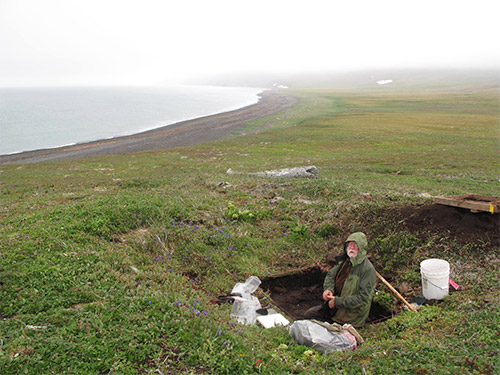
Alaska Science
Thule people had northern
life figured out
By NED ROSELL
April 05, 2016
Tuesday AM
(SitNews) - About 1,000 years ago, Norse explorer Leif Ericson bumped into the New World at Newfoundland. The old world was filling up, with 300,000 people living in the Roman capital of Constantinople. Up here in Alaska, the ancestors of today's coastal Natives were quietly having one of the more successful runs in human history.
The Thule people of Alaska's west and north coasts lived a good life for centuries, perfecting technologies that traveled with them across the northern Arctic all the way to Greenland. This April is Alaska Archeology Month, a time to think about people who mastered life in the far north before anyone in the more populated world knew about them.

Archeologist Dennis Griffin examines the remains of a housepit from Thule-era people who lived briefly on St. Matthew Island in about 1650.
Photo by Ned Rozell
How do you thrive so far from the equator and all its edible plants and animals? The Thule hunted the largest animal to be found up here, the bowhead whale.
Thule people invented the umiaq, a boat of sewn walrus hide. Umiaqs allowed Thule people to intercept the slow-moving whales and harpoon them. When a whale was struck and recovered, the hunters had more than 30 tons of food. They also had building materials; they framed their sod houses with whale bones along with driftwood.
Jeff Rasic has seen the sunken ovals of coastal tundra that were Thule house pits, as well as the mounds enriched by bones and other organic refuse left by those people near the present town of Barrow.
"There's about 13 mounds littered with whalebones," said Rasic, an archeologist with the National Park Service. "As we were there mapping this site, people were there duck hunting. People shot ducks and started plucking them right on the mounds."
That was a lightbulb moment for Rasic. People were attracted to that place today just as they were many generations ago.
The Thule of A.D. 1000 developed many things Native elders recognize today. Among the tools that stuck were the ulu, the knife with the curved blade so effective at slicing blubber and fish; kayaks, the pointed boats so stable in the ocean; snow goggles made of bone cut with narrow slits; and advanced harpoon tips attached to floats made of inflated seal skins (to find struck but submerged whales). The Thule were also among the first people to use dogs to help with travel and safety.
In the chill of the far north, Thule people have lived on in what they have left behind.
"There are hundreds of Thule sites out there," Rasic said. "Those in Greenland have great similarities to those in Barrow and the Seward Peninsula."
After centuries of living well off the country, Thule people experienced changes around 1850. Not only did a cold period known as the Little Ice Age thicken sea ice and make the air-breathing bowheads more elusive, but Thule people had been found, as western explorers and commercial whalers permeated the far north.
The Thule communities waned after that contact, but today's Inupiat descendants of Thule people trace some of their richest traditions back to a culture that had things dialed in.
"They were wealthy, successful people," Rasic said of the Thule. "Their adaptations worked really well. They were just fine-tuning them for more than 1,000 years."
Since the late 1970s, the University of Alaska Fairbanks’ Geophysical Institute has provided this column free in cooperation with the UAF research community.
Ned Rozell [nrozell@gi.alaska.edu] is a science writer for the Geophysical Institute.
Representations of fact and opinions in comments posted below are solely those of the individual posters and do not represent the opinions of Sitnews.
Publish A Letter in SitNews
Contact the Editor
SitNews ©2016
Stories In The News
Ketchikan, Alaska
|
Articles &
photographs that appear in SitNews may be protected by copyright
and may not be reprinted without written permission from and
payment of any required fees to the proper sources.
E-mail your news &
photos to editor@sitnews.us
Photographers choosing to submit photographs for publication to SitNews are in doing so granting their permission for publication and for archiving. SitNews does not sell photographs. All requests for purchasing a photograph will be emailed to the photographer.
|
|

